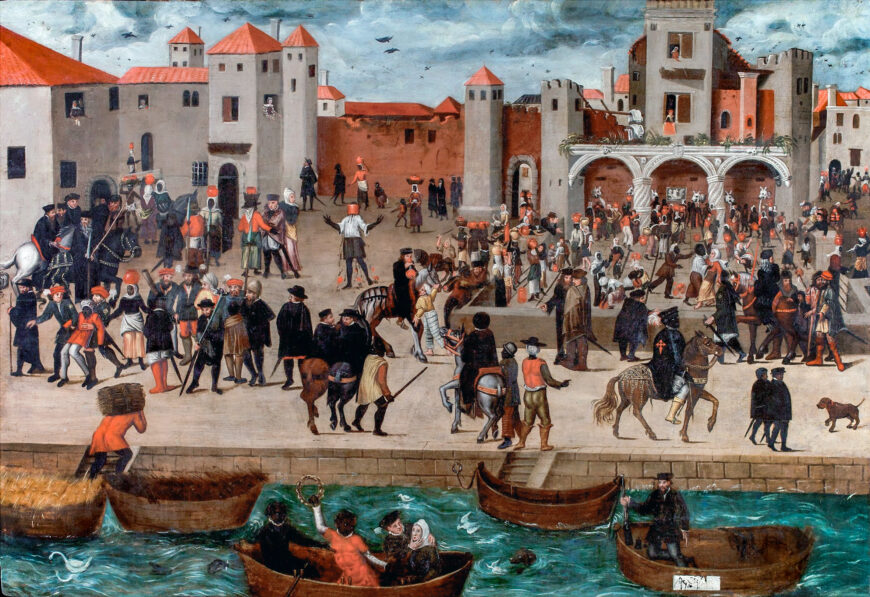
Chafariz d’El Rei, late 16th century (Netherlandish), oil on panel, 93 x 163 cm (The Berardo Collection, Lisbon)
In the late 1990s, a 16th-century painting depicting one of the main public places in early modern Lisbon, the Chafariz d’El Rei (the King’s Fountain), was bought by the Portuguese millionaire José Berardo. Many people doubted the authenticity of the painting when it was first displayed publicly in 1999 in the exhibition “Os negros em Portugal: séculos XVI-XIX” (Blacks in Portugal: 16th–19th centuries) in Lisbon’s Jerónimos monastery. Although the presence of Black people in late medieval and early modern Portugal, and in Lisbon in particular, has been well-studied, many argued that the painting could not be from 16th-century Lisbon due to the large number of Black people depicted in it. The matter was mostly settled in 2017 when experts in Lisbon’s Museu Nacional de Arte Antiga (National Museum of Ancient Art, MNAA) conducted a technical analysis and dated the painting to 1570–80, also determining that it might be by an unknown Netherlandish artist. All this happened as Portuguese society continues to debate its imperial and colonial history, a debate that remains far from over. Political conservatives, like Mr. Berardo, celebrate a traditional reading of Portugal’s past, while a younger generation, led by Black Portuguese people, call for a reckoning with Portugal’s not so distant colonial legacy (for example, Portugal held Angola as a colonial possession until 1975).
A large Black presence
Chafariz d’El Rei shows the King’s Fountain in the Alfama district on a feast day. At the time, public spaces were of paramount importance. It was there that commerce transpired and people socialized and formed and maintained social networks. The King’s Fountain was a particularly important space where a large swath of the city regularly gathered away from the center of power on the newer side of the city. Before running water in homes, public fountains were an essential service, and the painting highlights the laborious task, most often assigned to Black women, of carrying water in red ceramic jugs from the fountain to homes. The painting does not represent a single moment or scene, but is a composite that attests to the large Black presence in 16th-century Lisbon, whose 10,000 to 12,000 Black inhabitants constituted ten percent of the city’s total population. The city had the highest concentration of Black inhabitants in Europe, and foreign visitors often commented on the city’s Black population in their travel accounts and letters.
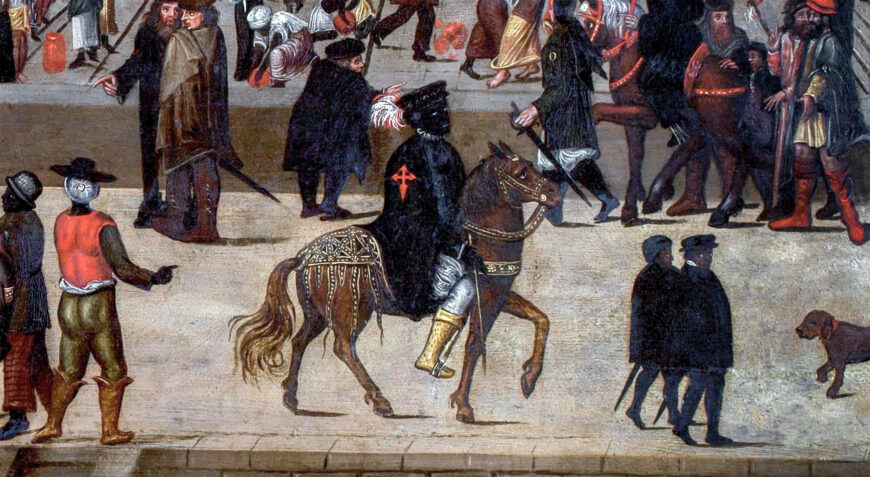
Knight João de Sá Panasco on pony (detail), Chafariz d’El Rei, late 16th century (Netherlandish), oil on panel, 93 x 163 cm (The Berardo Collection, Lisbon)
In the lower right, we see four Black knights, identifiable by their clothing and swords. Two knights are walking on foot. Another knight, who we see from the back (not seen in the detail above), is riding on a donkey. The knight featured more prominently is riding on a pony. This knight, who has been identified by name as João de Sá Panasco, has the red cross of the prestigious military order of Saint James on his right sleeve. Sá was born in West Africa around 1520, and was enslaved in Lisbon as a teenager, where a powerful aristocrat, also named João de Sá, bought him. In the 1540s, after being freed by the white Sá, the Black Sá served in the royal court of King John III, first as a jester and eventually as a page.
King John made Sá a knight for this service. He died sometime between 1560 and 1570. His regalia, boots, and the adornments on the pony underscore Sá’s high social status. These four knights demonstrate that Black Portuguese people could reach elite social status in early modern Portugal—though it must be noted that only donkeys and ponies (not horses) were available to these knights, perhaps due to horses’ high price. These Black knights were one of the main reasons why Portuguese scholars doubted the painting’s authenticity. They argued that knightly orders were regulated according to blood purity laws, which restricted membership to people who could prove that their ancestry was white and Christian for at least three generations. However, Hector Linares, a scholar studying how non-whites gained access to these prestigious orders, has shown that sometimes Iberian kings, who commanded these orders, bypassed these rules and admitted non-white men to them as reward for service to the crown, as in Sá’s case.
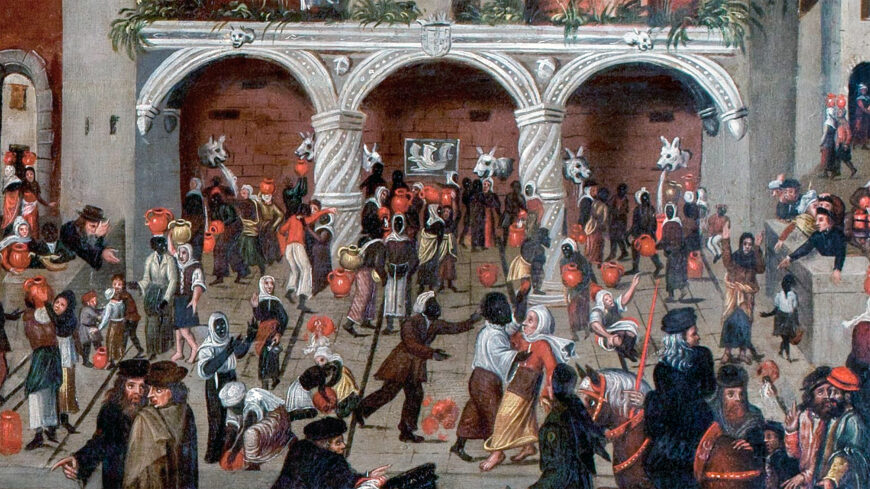
Festive scene, upper right, with dancing (detail), Chafariz d’El Rei, late 16th century (Netherlandish), oil on panel, 93 x 163 cm (The Berardo Collection, Lisbon)
In the upper right, we see a festive scene, with a Black couple dancing and, strikingly for many, a Black man dancing with a white woman. This scene, like others in the painting, may have been meant to be comical. Around them, people are fetching water in red jugs from the King’s Fountain. Along with the tambourine player at the bottom center of the painting, these dancers bear witness to Afro-Lisboetas’ (Lisboners of African descent) well-documented festive traditions.
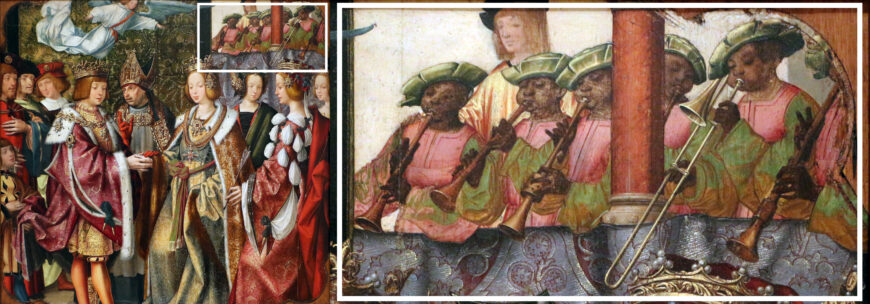
Black horn players (detail, right), The Engagement of Saint Ursula and Prince Etherius panel, Saint Auta Altarpiece, 1522–25, oil on panel, 67 x 72 cm; 66.5 x 71.9 cm (Museu Nacional de Arte Antiga, Lisbon)
For example, when Frederick III married Eleanor of Portugal in 1452, the wedding festivities included Black dancers. Moreover, we see Black musicians in the Portuguese court in a set of paintings commissioned in 1522 by princess Eleanor of Viseu for the Convent of the Madre de Deus in Lisbon.
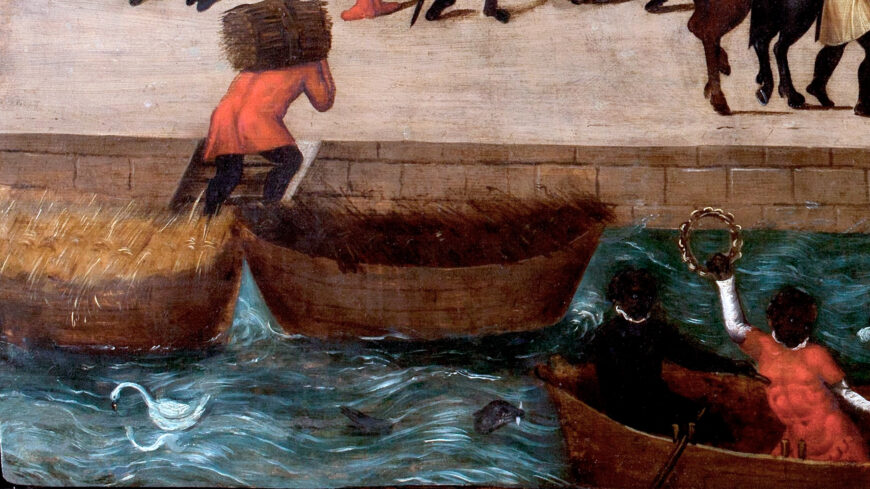
Unloading a boat (detail), Chafariz d’El Rei, late 16th century (Netherlandish), oil on panel, 93 x 163 cm (The Berardo Collection, Lisbon)
Varied labors
On the lower left corner, we see a Black man unloading a boat. This laborer, the Black people fetching water from the King’s Fountain, and the gondolier on the right lower corner (who recalls the well-documented Black gondoliers of early modern Venice) show the varied labors Black people carried out in early modern Lisbon.
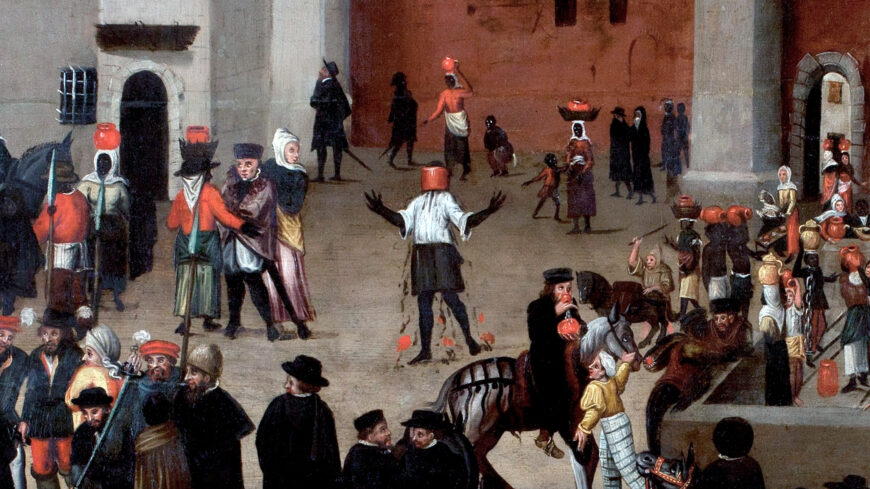
Man bleeding (detail), Chafariz d’El Rei, late 16th century (Netherlandish), oil on panel, 93 x 163 cm (The Berardo Collection, Lisbon)
On the upper left square, the painting shows the violence to which Afro-Lisboetas were subjected. Significantly, at the very center of the painting, we see a Black man bleeding after his head has been put through a water jug (or according to Halikowski Smith, performing some ritual involving fire). This figure (like the Black and white dancing couple) too seems to have been intended to be humorous. Moreover, in the lower left corner, another Black man is being carried away by authorities, while the Black woman behind him, possibly his wife, seems to wonder why—a scene not unfamiliar today.
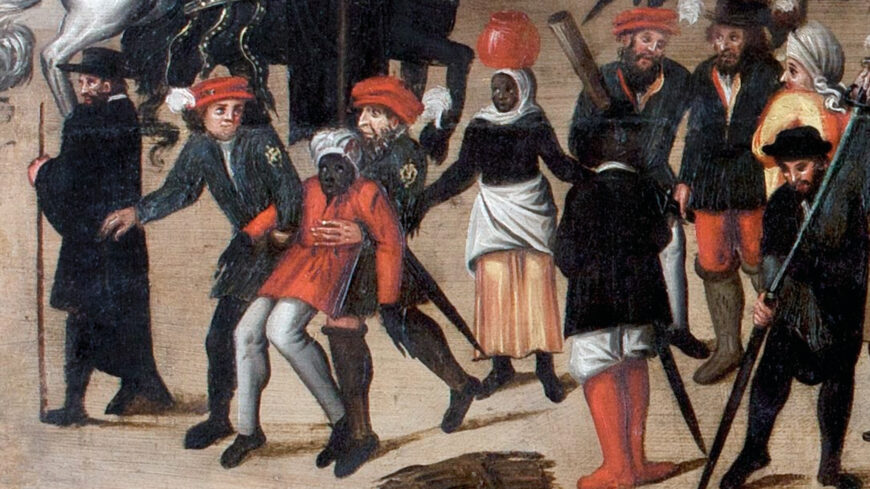
Woman questioning man’s arrest (detail), Chafariz d’El Rei, late 16th century (Netherlandish), oil on panel, 93 x 163 cm (The Berardo Collection, Lisbon)
The painting highlights the variety of peoples and activities associated with the city of Lisbon. Well-dressed white women remain sequestered within the domestic sphere, looking out of windows. White women with bare feet, a traditional visual symbol of poverty, work and mingle in the streets. Children, men with long grey beards, work, and leisure are all portrayed. The painting’s comical elements suggest that it may have been done in the spirit of the celebrated Dutch painter Pieter Bruegel the Elder.
Interpretations of the painting’s intended purpose vary but the overrepresentation of Black people may hold a clue. The Dutch artist may have meant to criticize Lisbon as a “Black” city where the institution of slavery was more common than in other parts of Europe. The depictions of violence against Black people might be a critique of Portuguese race relations. Yet, the Black knights suggest more positive possibilities, and the focus on the fountain presents the city as a wealthy and healthy place to live.
By the 20th century, the painting was in an art collection outside of Portugal (possibly in the Netherlands), suggesting that the painting appealed to travelers or others who wished to showcase Lisbon’s remarkable features. Including both the good and the bad would have allowed the painting to serve as a conversation starter.
Whatever its intended purpose, Chafariz d’El Rei is an important record of the varied lives, labors, punishments, and cultural activities of Black Portuguese people in early modern Lisbon. It is a pity therefore that the painting remains in Mr. Berardo’s private collection (in one of his private homes outside Lisbon) as the debate about Portugal’s colonial past continues, when it should be displayed in a public museum for everyone to see.
Additional resources
Stefan Halikowski-Smith, “Lisbon in the sixteenth century: decoding the Chafariz d’el Rei,” Race & Class, volume 2, number 60 (2018), pp. 63–81.
Annemarie Jordan, “Images of Empire: slaves in the Lisbon household and court of Catherine of Austria,” Black Africans in Renaissance Europe (Cambridge: Cambridge University Press, 2005), pp.155–80.
Annemarie Jordan-Gschwend and Kate J. P. Lowe, The Global City: on the Streets of Renaissance Lisbon (London: Paul Holberton Publishing, 2015).
Héctor Linares, “Imagining Black Knighthood in Early Modern Iberia: the Black Knight of the Order of St. James in Chafariz d’el-Rei,” The Routledge Companion to Early Modern Artistic, Material and Visual Production (forthcoming).
Kate Lowe, “Visible Lives: Black Gondoliers and Other Black Africans in Renaissance Venice,” Renaissance Quarterly, volume 2, number 66 (2013), pp. 412–52.
Joaneath A. Spicer, editor, Revealing the African Presence in Renaissance Europe (Baltimore: Walters Art Museum, 2012).

